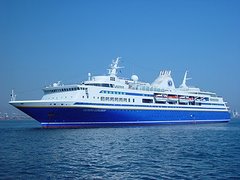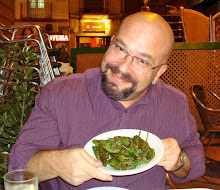Thanks to the guilt trip inspired by Leslie, et. al., I am returning to my long-neglected blog to report about our adventures. We’re sailing south along the coast of Peru, on our way to Chile, where wintry weather awaits. As you may have seen on Zoë’s blog, Panama was a pleasant surprise. The Canal was much more interesting than we’d expected, and the food was very good. If you’re in Panama City, try the restaurant Casuale in the Casco Antiguo.
After two frenetic days of class, we pulled into Guayaquil. After getting off the boat, we headed for Guyaquil’s shiny new Malecón, and its not so shiny iguana park. The park is actually one of the traditional squares in the city, but it’s called the iguana park because of all the – you guessed it! – iguanas that live there. I discovered the hard way that one should not stand too long beneath a tree crawling with iguanas, since all of them eventually have to relieve themselves, even if it might be on the head of a hapless Spanish professor.
The afternoon got us on a flight to Cuenca (barely), the small city in the mountains where we had decided to spend a few days. I went under duress, remembering the rather dull time we’d had in Cuenca 15 years ago (Rather dull? We actually considered taking Benadryl to sleep through the rest of our stay . . . Another story), and was surprised to found out how fabulous the place was. Cuenca has none of the monumental grandeur of Quito. Not one of its churches, museums or mountain peaks stands out as a spectacular “must-see,” world class attraction. But the whole city just drips with charm, making it the perfect place to walk around and make small discoveries.
The real surprise in our visit, however, was the day we spent with the Community Tourism program at the Centro Cultural Mama Kinua. “Community Tourism” is the name given to a nation-wide effort to bring tourists into direct contact with indigenous groups. Indigenous communities throughout the whole country invite visitors into their lives, and the money the tourist pays goes to support the community by financing things like health centers and schools. (My cousin Patricia, it turns out, is going on a visit of several days to the Hoarani in the Ecuadorian Amazon later this month. Imagine blow guns, huts in the rain forest, and no indoor plumbing for miles around. Go, Patricia!!!) The CCMK took us out to a local Cañari community, where Don Alfonso, a Cañari man, fed us, played music for us, lead us on a hike through an old growth forest to teach us about local medicinal plants, and generally told us everything we wanted to know about Cañari culture and about being indigenous in contemporary Ecuador. After years of traveling to Ecuador and seeing indigenous life from the outside, I was thrilled by the opportunity to spend the day with an indigenous person and have him tell us about his life from inside. Zoë and the Kid loved it too. There was a hint of sadness to it all, though, when you realized that Don Alfonso was doing his best to shore up a beleagured culture, one threatened by globalization and American influence. I was left wondering if his cute young grandkids would still speak Quichua when they were his age.
Now I’m writing from the ship, where I’ve agreed to serve as interim Academic Dean while David Gies goes off to Paris to attend the meeting of the International Association of Hispanists. The job is keeping me busier than I had expected, since it’s midterm season on the ship, and the students are stressed out, anxious, and frustrated with their workloads. It reminds me of UVA at finals time, when the Starbucks on the Corner becomes the seventh circle of Hell. I hope our attempts to make the program more rigorous haven’t gone over the top . . .
It’s incredibly hard to get work done on the ship, since the whole thing is designed for relaxing and socializing, not for study. I was up until 2am preparing a lecture on the invention of America. To some extent this was because PowerPoint is a hideous trap designed to consume time extravagantly (Did I pick the right animation? How can I get it to zoom in on that detail from the map?), and in part because the culture of chit-chat, as I like to call it, sucks time like you wouldn’t believe.
In any case, a lot of the chit-chat last night took the form of reports from friends returning from Quito, Cuenca, the Amazon, and Galapagós, full of enthusiasm for Ecuador and plans to return. There was less enthusiasm from those who had chosen to spend the whole time in Guayaquil. Guess the iguanas got to them as well.
(For pictures, see Zoë's blog. The 'net is too slow for me to post any right now.)
Teaching with Semester at Sea, Summer of 2007
If the title of this blog does not get a famous TV theme song stuck in your head, then please please click here.
Subscribe to:
Post Comments (Atom)



6 comments:
Woo- hoo! I am in inspiration! You made my day! My week! My year! My life!
Leslie
I am glad you saw Ecuador form another point of view... el de verdad... me debes informacion en un e-mail
Besos a todos
Tita
Keep it coming, kiddo. I know you're working your tail off but it still sounds exciting to me!
You never know. Maybe his grandkids won't speak Quichua and his great-grandkids will. Hawaiian has had quite a renaissance in the past couple of decades. Sometimes languages come back -- it's cool when they do.
Fun reading!
--Monica
I can't wait for our visit to Cuenca. You will have to tell me how to hook up with those guides. Did you see Tadeo Torres were Natali was from? Did you eat at Rumi Pampa (I think that's the name?)
Hi Guys
Zoe your blog was not avaklable at this time Thought I would update you on the neighborhood. Said goodbye to Daavid, Holly and the kids this morning. David said whoever is rentin g the house had kids so hopefully Iggy will have someone to play with. The people in the Woerpole house have 3 dogs and 2 parrots Nice People love Marion
Post a Comment